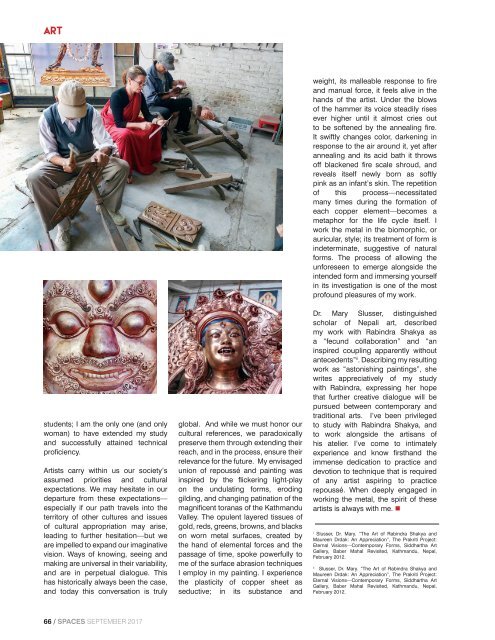SPACES Sept issue 2017
You also want an ePaper? Increase the reach of your titles
YUMPU automatically turns print PDFs into web optimized ePapers that Google loves.
ART<br />
students; I am the only one (and only<br />
woman) to have extended my study<br />
and successfully attained technical<br />
proficiency.<br />
Artists carry within us our society’s<br />
assumed priorities and cultural<br />
expectations. We may hesitate in our<br />
departure from these expectations—<br />
especially if our path travels into the<br />
territory of other cultures and <strong>issue</strong>s<br />
of cultural appropriation may arise,<br />
leading to further hesitation—but we<br />
are impelled to expand our imaginative<br />
vision. Ways of knowing, seeing and<br />
making are universal in their variability,<br />
and are in perpetual dialogue. This<br />
has historically always been the case,<br />
and today this conversation is truly<br />
global. And while we must honor our<br />
cultural references, we paradoxically<br />
preserve them through extending their<br />
reach, and in the process, ensure their<br />
relevance for the future. My envisaged<br />
union of repoussé and painting was<br />
inspired by the flickering light-play<br />
on the undulating forms, eroding<br />
gilding, and changing patination of the<br />
magnificent toranas of the Kathmandu<br />
Valley. The opulent layered t<strong>issue</strong>s of<br />
gold, reds, greens, browns, and blacks<br />
on worn metal surfaces, created by<br />
the hand of elemental forces and the<br />
passage of time, spoke powerfully to<br />
me of the surface abrasion techniques<br />
I employ in my painting. I experience<br />
the plasticity of copper sheet as<br />
seductive; in its substance and<br />
weight, its malleable response to fire<br />
and manual force, it feels alive in the<br />
hands of the artist. Under the blows<br />
of the hammer its voice steadily rises<br />
ever higher until it almost cries out<br />
to be softened by the annealing fire.<br />
It swiftly changes color, darkening in<br />
response to the air around it, yet after<br />
annealing and its acid bath it throws<br />
off blackened fire scale shroud, and<br />
reveals itself newly born as softly<br />
pink as an infant’s skin. The repetition<br />
of this process—necessitated<br />
many times during the formation of<br />
each copper element—becomes a<br />
metaphor for the life cycle itself. I<br />
work the metal in the biomorphic, or<br />
auricular, style; its treatment of form is<br />
indeterminate, suggestive of natural<br />
forms. The process of allowing the<br />
unforeseen to emerge alongside the<br />
intended form and immersing yourself<br />
in its investigation is one of the most<br />
profound pleasures of my work.<br />
Dr. Mary Slusser, distinguished<br />
scholar of Nepali art, described<br />
my work with Rabindra Shakya as<br />
a “fecund collaboration” and “an<br />
inspired coupling apparently without<br />
antecedents” ii . Describing my resulting<br />
work as “astonishing paintings”, she<br />
writes appreciatively of my study<br />
with Rabindra, expressing her hope<br />
that further creative dialogue will be<br />
pursued between contemporary and<br />
traditional arts. I’ve been privileged<br />
to study with Rabindra Shakya, and<br />
to work alongside the artisans of<br />
his atelier. I’ve come to intimately<br />
experience and know firsthand the<br />
immense dedication to practice and<br />
devotion to technique that is required<br />
of any artist aspiring to practice<br />
repoussé. When deeply engaged in<br />
working the metal, the spirit of these<br />
artists is always with me. •<br />
i<br />
Slusser, Dr. Mary. “The Art of Rabindra Shakya and<br />
Maureen Drdak: An Appreciation”, The Prakriti Project:<br />
Eternal Visions—Contemporary Forms, Siddhartha Art<br />
Gallery, Baber Mahal Revisited, Kathmandu, Nepal,<br />
February 2012.<br />
ii<br />
Slusser, Dr. Mary. “The Art of Rabindra Shakya and<br />
Maureen Drdak: An Appreciation”, The Prakriti Project:<br />
Eternal Visions—Contemporary Forms, Siddhartha Art<br />
Gallery, Baber Mahal Revisited, Kathmandu, Nepal,<br />
February 2012.<br />
66 / <strong>SPACES</strong> SEPTEMBER <strong>2017</strong>

















